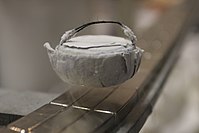
Photo from wikipedia
Superconducting magnetic levitation has been used in contactless mechanical components for different applications like bearings or positioning devices. This technology is currently being investigated for its potential use as a… Click to show full abstract
Superconducting magnetic levitation has been used in contactless mechanical components for different applications like bearings or positioning devices. This technology is currently being investigated for its potential use as a vibration isolation and thermal disconnect passive mechanism to support the focal plane array of the ESA ATHENA scientific telescope. Although it is well known that superconducting levitation properties depends on temperature, theoretical models have difficulties with complex bearing geometries or capturing inhomogeneity in material properties. In addition, experimental studies focused on the characterization of the mechanical properties of superconducting magnetic bearings are scant and mostly carried out with zero-field-cooled thrust bearing configurations. In order to increase the maturity of the technology for its potential use in space applications, further experimental research of the superconducting levitation properties at different temperatures is required. In this paper, we present the results of an experimental study of the levitation mechanical properties of a journal superconducting suspension in a high vacuum and temperatures from 90 to 12 K. Axial stiffness quadratically increases at lower temperature and linearly in the radial direction. However, the hysteresis loss factor decreases when decreasing the temperature for both axial and radial directions of displacement. These results demonstrate that the temperature influence on superconducting levitation systems is significant, and thus, mechanical engineers must consider it for design of superconducting levitation systems subjected to temperature variations.
Journal Title: IEEE Transactions on Applied Superconductivity
Year Published: 2019
Link to full text (if available)
Share on Social Media: Sign Up to like & get
recommendations!